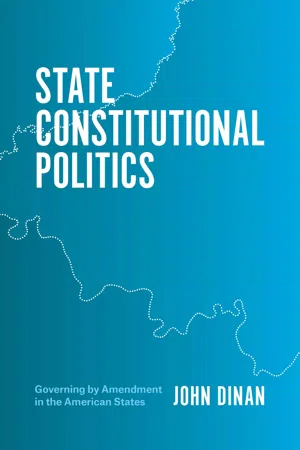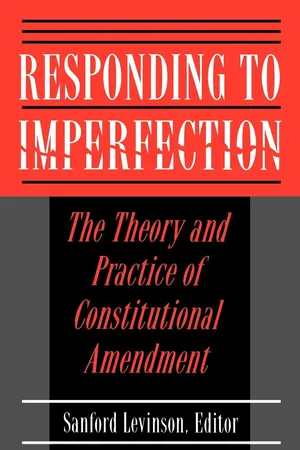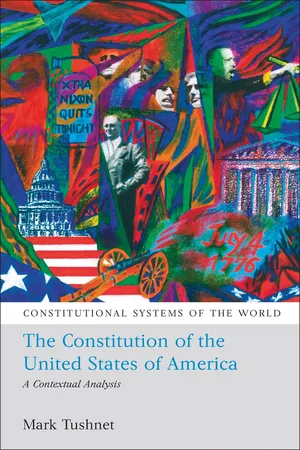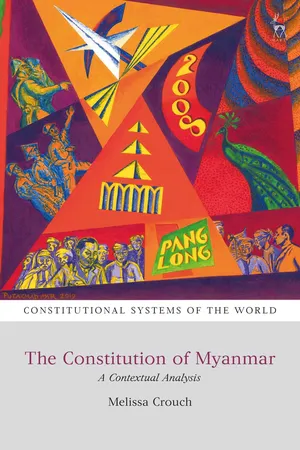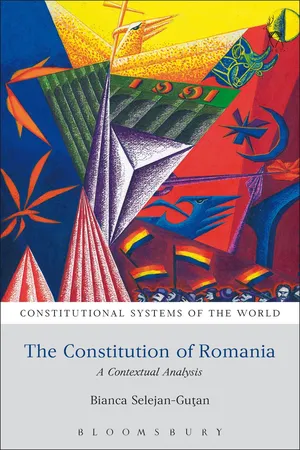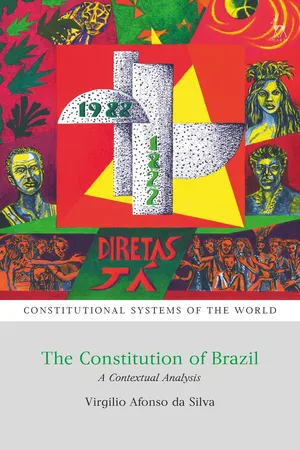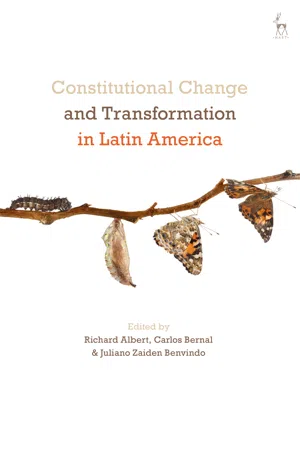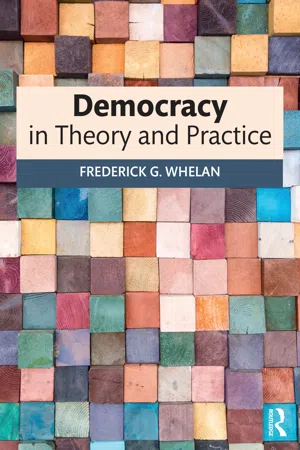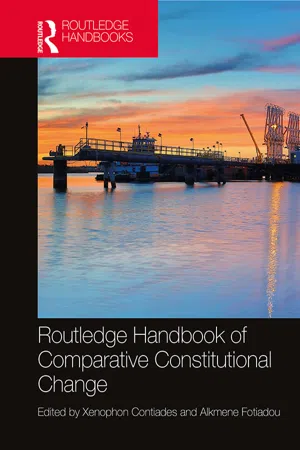Politics & International Relations
Constitutional Amendment Process
The constitutional amendment process refers to the formal procedure for making changes to a country's constitution. This typically involves a series of steps, such as proposal, ratification, and enactment, which are outlined in the existing constitution. The process is often designed to be deliberate and difficult in order to ensure that amendments reflect broad consensus and are not made hastily.
Written by Perlego with AI-assistance
Related key terms
Related key terms
1 of 4
Related key terms
1 of 3
10 Key excerpts on "Constitutional Amendment Process"
- eBook - ePub
State Constitutional Politics
Governing by Amendment in the American States
- John Dinan(Author)
- 2018(Publication Date)
- University of Chicago Press(Publisher)
PART IAmendments
Passage contains an image
CHAPTER ONEState Constitutional Amendment Processes and Practices
To explain why state constitutional amendments play a prominent role in state politics and governance, I first turn to the design of state amendment processes. These processes have not always been as flexible as they are in the twenty-first century; they only gradually became more flexible over time. Nor are the amendment processes equally accessible in all states. Yet they are in nearly all respects more accessible than the federal process.Due in part to the accessibility of state amendment processes, along with a willingness of citizens and public officials to make use of them, state constitutions are amended frequently. States vary in how frequently their constitutions are amended. Some state constitutions are amended once every few years, whereas in other states amendments are adopted several times each year. But every state constitution is amended more frequently than the US Constitution.State Constitutional Amendment Processes
In contrast with the US Constitution, which can only be amended by a two-thirds vote in Congress or a convention called after a petition from two-thirds of the states, followed by ratification in three-fourths of the states, the fifty state constitutions can be amended in ways that render them more flexible. Every state constitution allows the legislature to generate amendments. It is also understood in every state that the legislature can call a convention with the power to undertake a wholesale constitutional revision or submit amendments in piecemeal fashion to voters for ratification. Conventions can also be called in fourteen states through referenda that appear on the ballot automatically at regular intervals. Eighteen states provide for citizen-initiated amendments in which voters place amendments on the ballot and approve them, generally without a role for the legislature. In a number of states, commissions have been established with the power to recommend amendments for the consideration of legislators or conventions; in one state, commissions can even submit amendments directly to voters for ratification. - eBook - ePub
Responding to Imperfection
The Theory and Practice of Constitutional Amendment
- Sanford Levinson, Sanford Levinson, Sanford Levinson(Authors)
- 1995(Publication Date)
- Princeton University Press(Publisher)
8 However, the diffusion of written constitutions and the amendment idea do not necessarily indicate widespread acceptance of the principles that underlie the American innovation. In most countries with a written constitution, popular sovereignty and the use of a constitution as a higher law are not operative political principles. Any comparative study of the amendment process must therefore first distinguish true constitutional systems from those that use a constitution as window dressing, and then go on to recognize that among the former there are variations in the amendment process that rest on assumptions at odds with those in the American version. Indeed, it is the efficiency with which study of the amending process reveals such theoretical differences that draws us to it.At the same time, a comparative study of amendment processes allows us to delve more deeply into the theory of constitutional amendment as a principle of constitutional design. For example, we might ask the following questions: What difference does it make when constitutions are formally amended through a political process that does not effectively distinguish constitutional matters from normal legislation? Why might we still want to draw a distinction between formal amendment and revision by normal politics as carefully and as strongly as possible?One important answer to the question is that the three prominent methods of constitutional alteration other than complete replacement—formal amendment, legislative revision, and judicial interpretation—reflect, in the order listed, a declining commitment to popular sovereignty; and the level of commitment to popular sovereignty may be a key attitude for defining the nature of the political system. However, it is not always possible to tell when popular sovereignty has been abandoned for an elitist alternative. For example, some constitutions by design, and others by accident, leave so much room for interpretation that what some call amendment-through-interpretation is actually specification in the face of ambiguity. That is, those who write constitutions often purposely leave considerable room for interpretation. Formal constitutional provisions may not always define a single-peaked preference—that is, one clear choice that dominates all alternatives—but, rather, a range of acceptable possibilities, all of which may be understood as undergirded by popular sovereignty. As long as interpretation does not move outside a range of possibilities defined by a normal language interpretation of the constitutional provision, even if the operation of the political system is significantly changed as a consequence, there has not really been an amendment but rather a specification of a choice within a range of possibilities. Thus, rather than focusing only upon whether the operation of a political system is changed, we should also consider the range of possibilities permitted by a constitutional provision. - eBook - ePub
The Constitution of the United States of America
A Contextual Analysis
- Mark Tushnet(Author)
- 2008(Publication Date)
- Hart Publishing(Publisher)
7 The Processes of Constitutional Change Someone who attempted to understand constitutional change in the United States by reading the written Constitution’s provision on amending the Constitution would be misled. The formal amendment process is only one, and almost certainly the least important, of several mechanisms of constitutional change. Constitutional interpretation accounts for a much larger portion of constitutional change. Yet, though interpretation may be the statistically dominant form of constitutional change, it is not the structurally dominant form. That form is the ‘regime shift’, described, as we will see, somewhat misleadingly by law professor Bruce Ackerman as involving occasional constitutional ‘moments’ after which the array of institutions in the government as a whole is dramatically different from what it had been earlier. And, in general, shifts in constitutional interpretation as a mechanism of constitutional change occur as a result of changes in the courts attendant upon regime shifts. FORMAL AMENDMENTS Processes Article V of the Constitution sets out the formal amendment process. If supported by two-thirds of both houses of Congress, an amendment will be submitted to the states for ratification. A proposed amendment becomes part of the Constitution if it is ratified by three-quarters of the states. 1 There is no time limit set in the Constitution for ratification. Several amendments, by their own terms, specified that they had to be ratified within seven years, as they were. 2 The proposed Equal Rights Amendment dealing with gender equality was submitted to the states pursuant to congressional resolutions that set a similar time limit, but not embedded within the proposed amendment. The amendment secured ratifications from 35 states, three short of the needed three-quarters, when the seven years expired. Anticipating that outcome, Congress enacted an extension of the time period, the legality of which was challenged but not adjudicated - eBook - ePub
Engineering Constitutional Change
A Comparative Perspective on Europe, Canada and the USA
- Xenophon Contiades, Xenophon Contiades(Authors)
- 2012(Publication Date)
- Routledge(Publisher)
In its current formulation, it offers a certain number of advantages. 64 Most prominently, the current procedure involves three important institutions: the Houses of Parliament, the King (in modern terms, the Federal Government) and the people (through the requirement of general elections). The successive intervention of these state organs is undoubtedly a security against extreme or too emotional proposals of amendment. Moreover, the present process prevents the approval of modifications without sufficient discussion; it imposes a maturing of solutions and leads to a moderate rhythm of the amendment procedure. However, the current constitutional revision process as it is laid down in Art. 195 unfortunately also has some (very significant) inconveniences, which are principally due to its exceptionally rigid nature. Three of them in particular can be pointed out. 65 First, the fact that the amendment process is divided into three distinct and successive phases entails the risk that important and necessary constitutional modifications are not initiated because the political parties that would normally support them fear a possible defeat in the next parliamentary election (since the procedure, if started, necessarily leads to an election). So, in the beginning of a legislature, a reform proposal (and even a highly advisable one) will most probably not lead to the vote of a Declaration for Revision. Secondly, the dissolution of both Houses impairs the normal action of Parliament and Government: many politicians consider the main virtue of Art. 195 to be in the fact that it allows the Government to determine the date of the next general election. 66 The third inconvenience of the procedure is that the newly elected Houses may have a different majority than the previous Houses - eBook - ePub
The Constitution of Myanmar
A Contextual Analysis
- Melissa Crouch(Author)
- 2019(Publication Date)
- Hart Publishing(Publisher)
The second process is formal constitutional amendment. The amendment process is an example of a constitutional rule that gives a direct structural advantage to the Tatmadaw. There has been an overemphasis on the structural advantages of the Tatmadaw and a lack of attention to the Tatmadaw’s indirect advantages. It is critical that local perspectives on constitutional amendment are appreciated and taken seriously. For example, proponents of the Constitution argue that the formal amendment procedure only allows for ‘amendment’ of the Constitution, and not ‘addition’, ‘suspension’ or ‘removal’ of clauses. This is one reason why politicians are strategic in the proposals they advocated for and so the debate did not feature many of the more radical constitutional reforms that have been proposed.I. THE PEACE PROCESS: NORMALISING DEBATES ON FEDERALISMAt the start of the transition in 2011, it was clear that the Constitution had been unable to resolve the grievances of ethnic armed organisations and a new peace process was necessary. Although the peace process was initiated by the president through an exercise of executive power, the peace negotiation process has been led by the Tatmadaw and non-state actors. The peace process has had two unexpected outcomes. The first development is that the peace process has normalised debate and discussion of federalism, which in the past was a prohibited topic due to its perceived links to secession. The second development is that the 21-Panglong Conference under the NLD Government is acting like a quasi-Constituent Assembly, formulating 37 Principles that could form the basis of a revised Chapter I of the Constitution. This raises questions about public participation and the legitimacy of the process. - eBook - ePub
The Constitution of Romania
A Contextual Analysis
- Bianca Selejan-Gutan(Author)
- 2016(Publication Date)
- Hart Publishing(Publisher)
The initiative was referred to the Constitutional Court on 9 June 2011, and the Court issued its decision on 17 June 2011, deciding that six points of the proposal were unconstitutional on the ground that they exceeded the substantive limits of the amendment (suppressing elements of fundamental rights guaranteed by the Constitution) and suggesting revision of other proposed changes. The project was sent, together with the Constitutional Court’s decision, to the Romanian Parliament, with the express requirement that it examine it and make the changes suggested by the Constitutional Court. In Parliament a surprising thing happened: the parliamentary group of the Chamber of Deputies belonging to the ‘presidential’ party (PDL) assumed the project as its own and submitted it as initiator. Although it was registered and introduced on the agenda of the Legal Committee, the project was not discussed in the plenary chamber at once, but it was eventually rejected in 2013.After the change of the political majority in May 2012, and especially after the elections in December 2012, a new process of amendment started, triggered by the new political majority. The new initiative was drafted in May–July 2013.7 Following political changes in the spring of 2014 (the break-up of the governing coalition and the loss of the two-thirds majority necessary to amend the Constitution), the amendment process was put on hold.B. Informal ChangesIn Romanian constitutionalism, constitutional changes made without amending the Constitution are rare. Constitutional conventions and ‘informal constitutionalism’ do not have the chance to become established, as they will always be contested for not being written into the Constitution. The formal nature of constitutional change is a consequence, on the one hand, of the formalism of the Romanian legal system (which includes, inter alia, the primacy of written sources of law and the refusal of the courts to acknowledge judicial precedent) and, on the other hand, of the state’s seeming inability to innovate without ‘models’. New institutions and practices were adopted mainly because they had proved to be successful elsewhere. The role of history in this context is significant: virtually all constitutional changes in Romanian modern history were made under external pressure and/or by legal transplant. Therefore, the need for models has become an innate feature of Romanian constitutionalism. The above-mentioned appetite for formal change is deeply connected to the evaluation of constitutional transplant as a ‘magical panacea’, by continuously appealing to constitutional models with universalist claims, and with a never-ending, faithful attachment to the French ‘constitutional ingredients’. - eBook - ePub
The Constitution of Brazil
A Contextual Analysis
- Virgílio Afonso da Silva(Author)
- 2019(Publication Date)
- Hart Publishing(Publisher)
Nevertheless, the Constituent Assembly of 1987–88 provided for a constitutional revision to occur five years after its promulgation, that is, in 1993. Article 3 of the ADCT established that the Constitution ‘shall be revised after five years, counting from its promulgation, by vote of an absolute majority of members of the National Congress in a unicameral session’. The differences between the constitutional revision and the ordinary amendment process relate to both aim and procedure. While amendments aim to make specific changes to the Constitution, the 1993–94 constitutional revision was intended to be comprehensive. From a procedural point of view, the differences are even clearer: while amendments require three-fifths of the Chamber of Deputies and Federal Senate to be approved, the changes made during the 1993–94 constitutional revision demanded only an absolute majority in unicameral sessions.At the time of the constitutional revision, an important question arose: was the constitutional revision convention free to change anything in the Constitution or was it subject to the same limits set forth for constitutional amendments? The first case would potentially result in a total revision of the Brazilian Constitution. However, both the constitutional literature and the STF understood that the constitutional revision convention was bound to the same limits that applied to constitutional amendments.27In any case, lowering the required majority did not lead to a comprehensive constitutional revision. Only six amendments were approved, almost all of them with a rather minor impact, except for ECR 5/1994, which reduced the presidential term from five to four years.Because the Constitution does not provide for a second constitutional revision, since 1994 the ordinary amendment procedure has been the only path for reforming the Constitution. Nevertheless, time and again the summoning of an assembly with the specific aim of revising parts of the Constitution has been brought up as a way to overcome difficulties in making alterations, especially those related to the political and electoral systems. The rationale behind this idea is to take the decision about changing the rules of the political process away from those who have a personal interest in the matter, namely, incumbent federal deputies and senators. There is no consensus on the constitutionality of such a measure. Constitutional scholars are clearly divided on the matter, and since the idea has never materialised,28 - Richard Albert, Carlos Bernal, Juliano Zaiden Benvindo, Richard Albert, Carlos Bernal, Juliano Zaiden Benvindo(Authors)
- 2019(Publication Date)
- Hart Publishing(Publisher)
lack of opposition in State Legislatures when passing constitutional reforms. These two elements evidence that party discipline and centralisation of decision making is still present in constitution-amending processes, and still cuts across the federal and State level separation of powers. Put differently, fast track approvals and the lack of opposition show that like in the old regime party members are willing to align with the decisions made at the top of their party. The implication of these practices, of course, is that the constitutional mechanisms of horizontal accountability (in this case Article 135) would not function properly.In this section I analyse the constitutional amendments processes from 1997 to February 2017 to show the manifestation of the old regime practices. In doing so I analyse 94 amendment processes (formalised by the same number of constitutional amendment decrees). To do this analysis I created a data set of the time that it takes for a constitutional amendment bill to go through each of all the relevant steps of the Constitutional Amendment Process provided by Article 135 and congressional rules before being adopted. These steps include: (i) the presentation of the amendment bill; (ii) the legislative committee report assessing and proposing a text for the amendment in question (hereinafter report or recommendation); (iii) the discussion and approval of the report by the chamber of congress where the bill was presented (hereinafter chamber of origin); (iv) the reception of the amendment project at the chamber in charge of analysing the project in second turn (hereinafter reviewing chamber); (v) the legislative committee report at the reviewing chamber; (vi) the discussion and approval of the amendment project by the reviewing chamber; (vii) the approval by the state legislatures and formal declaration of the amendment adoption; and (viii) the enactment of the amendment. These eight steps, at the same time, form six stages. Stage 1 indicates the time it takes for the legislative committee to present the report from the moment the amendment bill was introduced. Stage 2 is the time it takes for the full chamber to discuss and approve a legislative committee report from the moment it is presented. Stage 3 refers to time in between the dispatch and reception of an amendment bill from the chamber of origin to the reviewing chamber. Stage 4 indicates the time it takes for the legislative committee to present the report since the reception of the bill. Stage 5 is the same as stage 2 but in the reviewing chamber. Stage 6 represents time in between the dispatching of the bill to the state legislatures and its approval. Stage 7 would be the time between the latter approval and the enactment of the amendment.- eBook - ePub
- Frederick G. Whelan(Author)
- 2018(Publication Date)
- Routledge(Publisher)
Constitutions must also be more stable (and therefore more difficult to alter) than ordinary laws, since they provide the procedures according to which ordinary legislative change takes place. Modern political constitutions generally follow the precedent set by the American prototype in including an amendment procedure, one that differs from ordinary legislation and that in a democracy is supposed to reflect the ultimate sovereignty of the people. Constitutions differ, however, in the ease or difficulty of amendment.Constitutions should be, and should be perceived as being, impartial and hence neutral among the various political forces and parties that compete for power under them. This is an ideal requirement that in practice can only be approximated, since alternative constitutional arrangements (for example, different systems of representation and electoral laws) will inevitably tend to favor some interests over others.10 This fact is sometimes obscured in the case of longstanding democratic constitutions, to which custom confers additional legitimacy, but it can be a source of contention when new constitutions are being drafted. In general, a constitution must be perceived as sufficiently neutral or fair by a large majority of the people and groups in a country or the legitimacy of the governmental institutions it establishes will be in doubt.In assigning specific powers to different institutions and offices, a constitution must enable governmental action adequate to the problems it will face. A capacity for ruling and for an appropriate level of decisiveness are desirable qualities in any government. This capability, however, must be reconciled with political opposition, free elections, and other forms of competition for influence. In sustaining this balance, the constitution must also contain (or enable the suppression of) potentially violent forms of conflict. Stabilizing democracy in societies divided by ethnicity or language has produced ongoing constitutional experimentation with devices such as proportionality, power-sharing, and local autonomy. - Xenophon Contiades, Alkmene Fotiadou, Xenophon Contiades, Alkmene Fotiadou(Authors)
- 2020(Publication Date)
- Routledge(Publisher)
24 However, this leads to a repeat of the Canada problem discussed above in relation to Lutz. Schneier identifies Canada as a country where a legislative amendment by simple majority combined with approval by provincial legislatures is required. But if this is the most common practice in Canada, it perhaps simply reflects that other amendment processes are too difficult to use. That is a highly salient fact that is obscured by Schneier’s typology.The typologies considered thus far have focused on the basic process through which constitutional changes must be approved. While some of the authors refer to the fact that there might be categorical restrictions on constitutional change, they make little effort to include those restrictions within their typologies. For some authors, this might be because this would multiply the problem of alternative procedures. How do we compare the difficulty of formal constitutional change in country X with country Y, if in country X the republican character of the state is amendable while in country Y the republican character of the state is not amendable? A further complicating factor is that many restrictions of this type derive not from the constitutional text but rather from judicial action.25In 2017, I published a chapter that provided a stand-alone typology of constraints on constitutional change powers. I argued that constraints on powers of constitutional amendment could be conceptualised in terms of three cross-cutting distinctions:23 Edward Schneier, Crafting Constitutional Democracies: The Politics of Institutional Design (Rowman & Littlefield 2006) 224–225.24 Ibid 225.25 See Yaniv Roznai, ‘Unconstitutional Constitutional Amendments: The Migration and Success of a Constitutional Idea’ (2013) 61 American Journal of Comparative Law 690.- Process v. content;
- Rule v. standard;
- Legislator-created v. court-created.26
Index pages curate the most relevant extracts from our library of academic textbooks. They’ve been created using an in-house natural language model (NLM), each adding context and meaning to key research topics.
Explore more topic indexes
Explore more topic indexes
1 of 6
Explore more topic indexes
1 of 4
